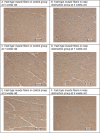Histological and contractile changes in the genioglossus muscle after nasal obstruction in growing rats
- PMID: 37069178
- PMCID: PMC10110532
- DOI: 10.1038/s41598-023-32921-w
Histological and contractile changes in the genioglossus muscle after nasal obstruction in growing rats
Abstract
The aim of the study was to address the genioglossus muscle physiological and histological changes after unilateral nasal obstruction in growing rats. Fifty-four 6-day-old male Wistar albino rats were randomly divided into control (n = 27) and experimental (n = 27) groups. Unilateral nasal obstruction was performed at 8 days old. Contractile properties of the genioglossus whole muscle were measured at 5-, 7- and 9-week-old, including the twitch and tetanic forces, contraction time, half-decay time, and fatigue index. The histological characteristics of the genioglossus were also evaluated at 5-, 7- and 9-week-old, analyzing the myosin heavy chain composition of the slow, fast, IIa and IIb muscle fiber type, by measuring the number, rate, diameter and cross-sectional area. The maximal twitch force, and tetanic force at 60 Hz and 80 Hz force was significantly increased at all ages after nasal obstruction. The fatigue index was decreased at 5 weeks-old after nasal obstruction. The diameter and cross-sectional area of the fast, IIa and IIb muscle fiber types were increased at 7 and 9 weeks after nasal obstruction, while only the diameter of IIa type and cross-sectional area of IIb type were increased at 5 weeks-old after nasal obstruction. Nasal obstruction during growth affects the whole genioglossus muscle contractile properties and histological characteristics, increasing its force, the diameter and area of its muscle fibers. These changes in the genioglossus muscle may affect the normal growth, development and function of the craniofacial complex.
© 2023. The Author(s).
Conflict of interest statement
The authors declare no competing interests.
Figures





Similar articles
-
Effect of unilateral nasal obstruction on tongue protrusion forces in growing rats.J Appl Physiol (1985). 2015 May 1;118(9):1128-35. doi: 10.1152/japplphysiol.01152.2014. Epub 2015 Mar 12. J Appl Physiol (1985). 2015. PMID: 25767036
-
Contractility and myosin isoform compositions of skeletal muscles and muscle cells from rats treated with thyroid hormone for 0, 4 and 8 weeks.J Muscle Res Cell Motil. 1997 Jun;18(3):335-44. doi: 10.1023/a:1018674126229. J Muscle Res Cell Motil. 1997. PMID: 9172075
-
Tongue muscle contractile, fatigue, and fiber type properties in rats.J Appl Physiol (1985). 2021 Sep 1;131(3):1043-1055. doi: 10.1152/japplphysiol.00329.2021. Epub 2021 Jul 29. J Appl Physiol (1985). 2021. PMID: 34323593 Free PMC article.
-
The role of neural and mechanical influences in maintaining normal fast and slow muscle properties.Cells Tissues Organs. 2006;182(3-4):129-42. doi: 10.1159/000093963. Cells Tissues Organs. 2006. PMID: 16914916
-
Muscle mechanics: adaptations with exercise-training.Exerc Sport Sci Rev. 1996;24:427-73. Exerc Sport Sci Rev. 1996. PMID: 8744258 Review.
References
-
- Chamberland M, Winter M, Brice TAW, Jones DK, Tallantyre EC. Beyond lesion-load: Tractometry-based metrics for characterizing white matter lesions within fibre pathways. Math. Visual. 2021 doi: 10.1007/978-3-030-73018-5_18. - DOI
Publication types
MeSH terms
Substances
LinkOut - more resources
Full Text Sources

